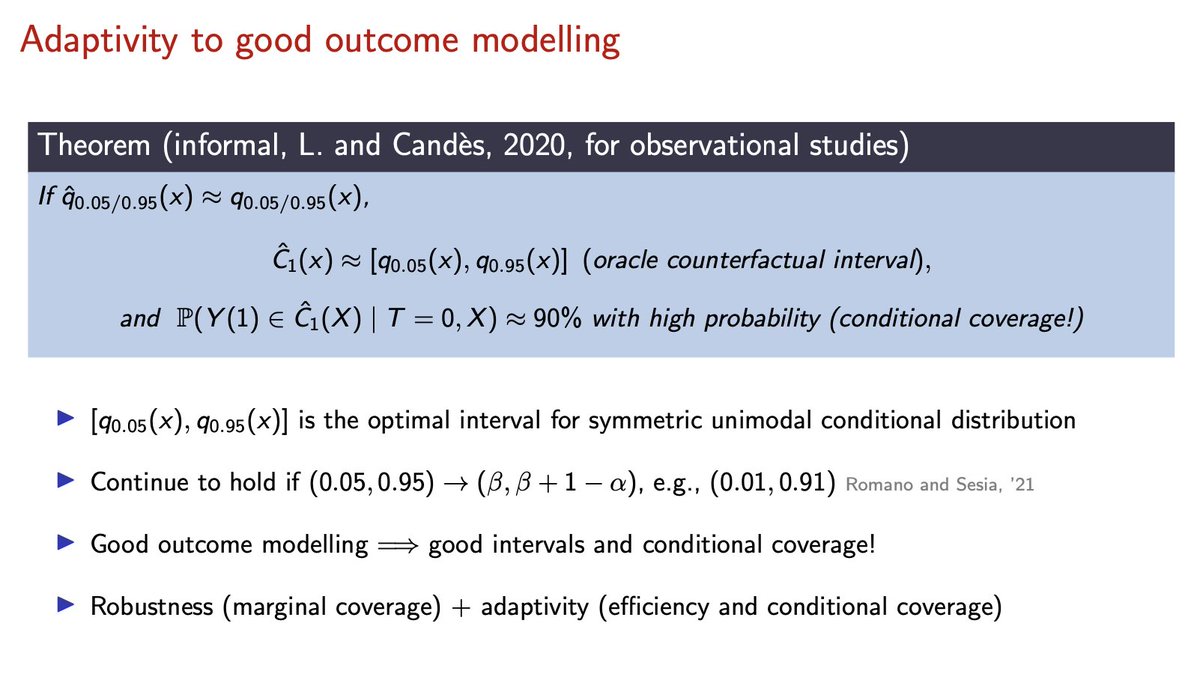
New paper alert🚨#statstwitter
Conformal inference, often framed as a technique to generate prediction intervals, is also a tool for out-of-distribution detection. We studied marginal/conditional conformal p-values for multiple testing with marginal/conditional error control 1/n
Conformal inference, often framed as a technique to generate prediction intervals, is also a tool for out-of-distribution detection. We studied marginal/conditional conformal p-values for multiple testing with marginal/conditional error control 1/n
https://twitter.com/stats_stephen/status/1384525910846558220
We consider the setting where a dataset of “inliers” is available. Existing outlier detection algorithms often output a “score” for each testing point indicating how regular it is.
But how to choose a cutoff to get guaranteed statistical error (e.g., type-I error) control? 2/n
But how to choose a cutoff to get guaranteed statistical error (e.g., type-I error) control? 2/n

For a single data point X, it can be formulated as a hypothesis testing problem with H0: X~P, where P is the (unknown) distribution of inliers X_1, …, X_n. Intuitively, H0 should be rejected if score(X) is too small compared to {score(X_1), …, score(X_n)}. 3/n
A conformal p-value for H0 is the rank of score(X) among the set {score(X), score(X_1), …, score(X_n)}, normalized by (n+1). For ANY scoring algorithm, the conformal p-value is uniformly distributed on {1/(n+1), 2/(n+1), …, (n+1)/(n+1)} and thus valid under the null. 4/n 

What happens if multiple testing points are to be tested?
For example, does the Benjamini-Hochberg procedure control the false discovery rate (FDR) for outlier detection?
It is not trivial at all since conformal p-values are dependent through {score(X_1), …, score(X_n)}. 5/n
For example, does the Benjamini-Hochberg procedure control the false discovery rate (FDR) for outlier detection?
It is not trivial at all since conformal p-values are dependent through {score(X_1), …, score(X_n)}. 5/n
Surprisingly, we prove that the BH procedure applied on conformal p-values controls FDR.
This is proved by showing that the conformal p-values satisfy a delicate property called PRDS, introduced in the pioneering work by Benjamini & Yekutieli (2001) projecteuclid.org/journals/annal… 6/n
This is proved by showing that the conformal p-values satisfy a delicate property called PRDS, introduced in the pioneering work by Benjamini & Yekutieli (2001) projecteuclid.org/journals/annal… 6/n
Another interesting finding: though the celebrated Storey-BH procedure fails to control FDR with PRDS p-values in general,
we prove that it controls FDR without any adjustment when applied to conformal p-values. It is based on a novel generic FDR bound for Storey-BH. 7/n
we prove that it controls FDR without any adjustment when applied to conformal p-values. It is based on a novel generic FDR bound for Storey-BH. 7/n

Now let’s turn to another important question: are type-I error and FDR defined above sensible error metrics?
The above ones marginalize over the inlier dataset. When it is expensive to obtain pure inliers, it would be safer to control the them conditional on the data. 8/n
The above ones marginalize over the inlier dataset. When it is expensive to obtain pure inliers, it would be safer to control the them conditional on the data. 8/n
To achieve conditional error control, the first step is to get conditional valid conformal p-values (defined in the figure). Unfortunately, marginal conformal p-values are not conditionally valid and adjustment is needed. 9/n 

We found an intriguing connection between conditionally valid conformal p-values and confidence bands of CDFs. In particular, unexpectedly, we found that the generalized Simes’ inequality (used for k-FWER control) yields a suitable adjustment formula for our purpose. 10/n 

Check out our paper for more details if you’re interested in outlier/out-of-distribution detection with conformal p-values!
arxiv.org/abs/2104.08279
11/n
arxiv.org/abs/2104.08279
11/n
• • •
Missing some Tweet in this thread? You can try to
force a refresh










